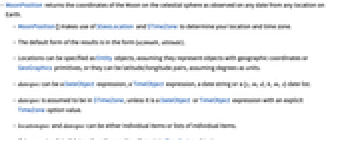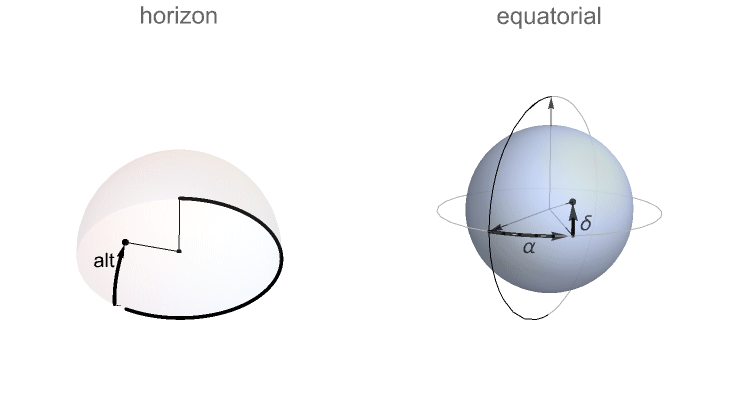gives the position of the Moon for the current date and location.
MoonPosition[datespec]
gives the position of the Moon for the specified date.
MoonPosition[locationspec]
gives the position of the Moon for the specified location.
MoonPosition[locationspec,datespec]
gives the position of the Moon for the specified date and location.
MoonPosition[{{location1,date1},{location2,date2},…}]
gives the positions of the Moon for all specified locations on the specified dates.
MoonPosition[locationspec,datespec,func]
uses func to determine what to return for extended locations.


MoonPosition
gives the position of the Moon for the current date and location.
MoonPosition[datespec]
gives the position of the Moon for the specified date.
MoonPosition[locationspec]
gives the position of the Moon for the specified location.
MoonPosition[locationspec,datespec]
gives the position of the Moon for the specified date and location.
MoonPosition[{{location1,date1},{location2,date2},…}]
gives the positions of the Moon for all specified locations on the specified dates.
MoonPosition[locationspec,datespec,func]
uses func to determine what to return for extended locations.
Details and Options



- MoonPosition returns the coordinates of the Moon on the celestial sphere as observed on any date from any location on Earth.
- MoonPosition[] makes use of $GeoLocation and $TimeZone to determine your location and time zone.
- The default form of the results is in the form {azimuth,altitude}.
- Locations can be specified as Entity objects, assuming they represent objects with geographic coordinates or GeoGraphics primitives, or they can be latitude/longitude pairs, assuming degrees as units.
- datespec can be a DateObject expression, a TimeObject expression, a date string or a {y,m,d,h,m,s} date list.
- datespec is assumed to be in $TimeZone, unless it is a DateObject or TimeObject expression with an explicit TimeZone option value.
- locationspec and datespec can be either individual items or lists of individual items.
- If datespec is a list of dates, then the results will contain TimeSeries objects.
- datespec can be specified as {start,end,increment} for compatibility with DateRange specifications.
- MoonPosition[…,func] is used to specify the format of output when locations are specified.
- Possible settings for func include:
-
Automatic returns intervals for extended locations only Interval returns intervals for all specified locations Mean returns mean value for extended locations Min returns minimum values for extended locations Max returns maximum values for extended locations StandardDeviation returns standard deviation for extended locations - MoonPosition[CelestialSystem->"Equatorial"] gives the right ascension and declination of the Moon.
- MoonPosition can accept the following options:
-
AltitudeMethod "ApparentAltitude" whether to take atmospheric refraction into account when computing altitude CelestialSystem "Horizon" whether to return azimuth/altitude or right ascension/declination - Possible settings for CelestialSystem include:
-
"Horizon" returns results as a pair of azimuth/altitude (az/alt) values "Equatorial" returns results as a pair of right ascension/declination (  /
/ ) values
) values - Possible settings for AltitudeMethod include:
-
"ApparentAltitude" take atmospheric refraction into account for altitude computations "TrueAltitude" assume no atmospheric refraction for altitude computations

Examples
open all close allBasic Examples (5)
Compute the current position of the Moon for your location:
Compute the position of the Moon for a specified date:
Compute the current position of the Moon for a specified location:
Compute the position of the Moon for a specified latitude/longitude and date:
Compute the position of the Moon for a specified city and date:
Scope (9)
Dates (3)
Dates can be specified as a DateObject:
Locations (6)
Locations can be latitude/longitude pairs:
Cities are treated as single, specific locations:
Results for extended locations are intervals, by default:
The form of the results for extended locations can be overridden:
Find the Moon's position for multiple locations:
Find the Moon's position for multiple locations on different dates:
Options (2)
AltitudeMethod (1)
The default setting for AltitudeMethod simulates atmospheric refraction:
Allow for no atmospheric refraction when computing the altitude of the Moon:
Applications (4)
The Moon's orbit is tilted with respect to the Earth's equator:
Plot the angular distance between the Sun and Moon over a month:
Reconstruct the Moon's orbital period using the position of the Moon over several months:
Extract the positions where the Moon's right ascension suddenly goes from 24 hours to 0 hours and find the mean period where this transition happens:
Compare this to the actual value of the Moon's orbital period:
Plot the position of the Sun and Moon on the celestial sphere:
Properties & Relations (4)
By default, location is specified by $GeoLocation and the date is specified by the current date:
Results are in the form of a TimeSeries when a range of dates is specified:
Results are multivalued for each date specification, so plotting the results using DateListPlot will result in two curves, one for azimuth and one for altitude:
Find the position of the Moon for this location and date:
This can also be computed with AstroPosition:
Possible Issues (2)
With MoonPosition[locationspec,Interval], results for specific locations are coerced into intervals:
Attempting to plot the results of MoonPosition using "Minute" granularity or larger can result in artifacts:
One workaround to such issues is to coerce the incoming date so that it has "Instant" granularity:
See Also
AstroPosition SunPosition AstroSubpoint PlanetaryMoonData MoonPhase SolarEclipse LunarEclipse TideData
Function Repository: MoonPositionPlot3D SkyChart
Related Guides
Text
Wolfram Research (2014), MoonPosition, Wolfram Language function, https://reference.wolfram.com/language/ref/MoonPosition.html (updated 2023).
CMS
Wolfram Language. 2014. "MoonPosition." Wolfram Language & System Documentation Center. Wolfram Research. Last Modified 2023. https://reference.wolfram.com/language/ref/MoonPosition.html.
APA
Wolfram Language. (2014). MoonPosition. Wolfram Language & System Documentation Center. Retrieved from https://reference.wolfram.com/language/ref/MoonPosition.html
BibTeX
@misc{reference.wolfram_2025_moonposition, author="Wolfram Research", title="{MoonPosition}", year="2023", howpublished="\url{https://reference.wolfram.com/language/ref/MoonPosition.html}", note=[Accessed: 12-December-2025]}
BibLaTeX
@online{reference.wolfram_2025_moonposition, organization={Wolfram Research}, title={MoonPosition}, year={2023}, url={https://reference.wolfram.com/language/ref/MoonPosition.html}, note=[Accessed: 12-December-2025]}